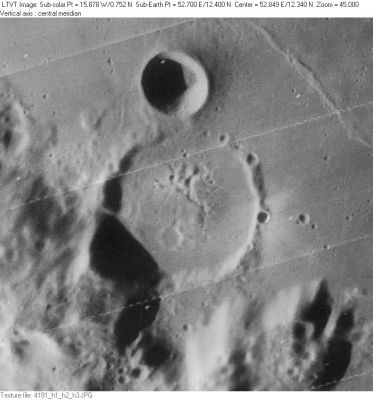Difference between revisions of "Greaves"
| Line 7: | Line 7: | ||
|} | |} | ||
<div id="toc"> | <div id="toc"> | ||
| − | + | [http://www.lpod.org/coppermine/albums/userpics/Lick-Greaves_LO-IV-191H_LTVT.JPG [[Image:normal_Lick-Greaves_LO-IV-191H_LTVT.JPG|external image normal_Lick-Greaves_LO-IV-191H_LTVT.JPG]]]<br /> ''[http://lpod.org/coppermine/displayimage.php?pos=-2542 LO-IV-191H]'' '''Greaves''' is the bowl-shaped crater at the top of the frame, with the large ghostly ring of [[Lick|Lick]] south of it. Ruined 23-km '''[[Lick|Lick]] A''' is partially visible just below [[Lick|Lick]]. The wrinkle-ridge in the upper right is not part of any named system.<br /> <br /> | |
| − | |||
==Images== | ==Images== | ||
[http://www.lpod.org/coppermine/thumbnails.php?album=search&type=full&search=Greaves LPOD Photo Gallery] [http://www.lpi.usra.edu/resources/lunar_orbiter/bin/srch_nam.shtml?Greaves%7C0 Lunar Orbiter Images] [http://www.lpi.usra.edu/resources/apollo/search/feature/?feature=Greaves Apollo Images] (see: [http://www.lpi.usra.edu/resources/apollo/search/feature/?feature=Lick+D&sort= Lick D])<br /> - A fully illuminated '''Greaves''' ('''Lick D''') was captured in Apollo 17's panoramic ''ITEK'' camera frame [http://www.lpi.usra.edu/resources/apollo/frame/?AS17-P-2687 AS17-P-2687]. You can't miss '''Greaves''' because here it is the most eye-catching formation!<br /> - '''Greaves''' was also captured in Apollo 17's oblique south-looking Mapping/ Metric ''Fairchild'' camera frame [http://www.lpi.usra.edu/resources/apollo/frame/?AS17-M-1639 AS17-M-1639] (rightward of the frame's centre).<br /> - Additional research: Danny Caes<br /> <br /> | [http://www.lpod.org/coppermine/thumbnails.php?album=search&type=full&search=Greaves LPOD Photo Gallery] [http://www.lpi.usra.edu/resources/lunar_orbiter/bin/srch_nam.shtml?Greaves%7C0 Lunar Orbiter Images] [http://www.lpi.usra.edu/resources/apollo/search/feature/?feature=Greaves Apollo Images] (see: [http://www.lpi.usra.edu/resources/apollo/search/feature/?feature=Lick+D&sort= Lick D])<br /> - A fully illuminated '''Greaves''' ('''Lick D''') was captured in Apollo 17's panoramic ''ITEK'' camera frame [http://www.lpi.usra.edu/resources/apollo/frame/?AS17-P-2687 AS17-P-2687]. You can't miss '''Greaves''' because here it is the most eye-catching formation!<br /> - '''Greaves''' was also captured in Apollo 17's oblique south-looking Mapping/ Metric ''Fairchild'' camera frame [http://www.lpi.usra.edu/resources/apollo/frame/?AS17-M-1639 AS17-M-1639] (rightward of the frame's centre).<br /> - Additional research: Danny Caes<br /> <br /> | ||
| Line 21: | Line 20: | ||
** Westfall, 2000: 2.41 km | ** Westfall, 2000: 2.41 km | ||
** Viscardy, 1985: 1.96 km | ** Viscardy, 1985: 1.96 km | ||
| − | * The shadow in Greaves indicates a depth of about 2500 m. <span class="membersnap">- | + | * The shadow in Greaves indicates a depth of about 2500 m. <span class="membersnap">- Jim Mosher</span> |
<br /> | <br /> | ||
==Nomenclature== | ==Nomenclature== | ||
* [http://en.wikipedia.org/wiki/William_Michael_Herbert_Greaves William Michael Herbert Greaves] (10 September 1897 – 24 December 1955) was a British astronomer. He is most noted for his work on stellar spectro-photometry. | * [http://en.wikipedia.org/wiki/William_Michael_Herbert_Greaves William Michael Herbert Greaves] (10 September 1897 – 24 December 1955) was a British astronomer. He is most noted for his work on stellar spectro-photometry. | ||
| − | * This replacement name for a formerly [[lettered%20crater|lettered crater]] was introduced on [http://www.lpi.usra.edu/resources/mapcatalog/LTO/lto62a1_1/ LTO-62A1]. <span class="membersnap">- | + | * This replacement name for a formerly [[lettered%20crater|lettered crater]] was introduced on [http://www.lpi.usra.edu/resources/mapcatalog/LTO/lto62a1_1/ LTO-62A1]. <span class="membersnap">- Jim Mosher</span> |
<br /> | <br /> | ||
==LPOD Articles== | ==LPOD Articles== | ||
| Line 33: | Line 32: | ||
<br /> <br /> | <br /> <br /> | ||
---- | ---- | ||
| − | + | </div> | |
Revision as of 16:24, 15 April 2018
Contents
Greaves (in the southwestern part of Mare Crisium)
(formerly Lick D)
|
Lat: 13.2°N, Long: 52.7°E, Diam: 13 km, Depth: 2.41 km, Rükl: 37 |
LO-IV-191H Greaves is the bowl-shaped crater at the top of the frame, with the large ghostly ring of Lick south of it. Ruined 23-km Lick A is partially visible just below Lick. The wrinkle-ridge in the upper right is not part of any named system.
Images
LPOD Photo Gallery Lunar Orbiter Images Apollo Images (see: Lick D)
- A fully illuminated Greaves (Lick D) was captured in Apollo 17's panoramic ITEK camera frame AS17-P-2687. You can't miss Greaves because here it is the most eye-catching formation!
- Greaves was also captured in Apollo 17's oblique south-looking Mapping/ Metric Fairchild camera frame AS17-M-1639 (rightward of the frame's centre).
- Additional research: Danny Caes
Maps
(LAC zone 62A1) LAC map Geologic map LM map LTO map
Description
Description: Wikipedia
Additional Information
- Depth data from Kurt Fisher database
- Westfall, 2000: 2.41 km
- Viscardy, 1985: 1.96 km
- The shadow in Greaves indicates a depth of about 2500 m. - Jim Mosher
Nomenclature
- William Michael Herbert Greaves (10 September 1897 – 24 December 1955) was a British astronomer. He is most noted for his work on stellar spectro-photometry.
- This replacement name for a formerly lettered crater was introduced on LTO-62A1. - Jim Mosher
LPOD Articles
Bibliography
